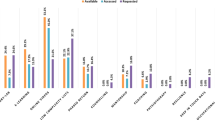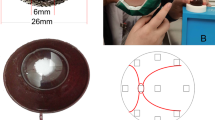Abstract
Introduction
Ophthalmic simulation is cost-effective in complication prevention. However, there is no consistent resource allocation to provide the necessary time and finance to sustain such activities. We wished to identify the current support for the regional Simulation Leads in the UK.
Methods
An online SurveyMonkey questionnaire was sent to all 26 UK ophthalmic regional Simulation Leads in February 2021 regarding current simulation activity and the degree of time and resource support available.
Results
There were 22 responses within 1 month (84.6% response rate). 72.7% run regular simulation induction events for new trainees. 60% run mandatory laser simulation events. 38.1% run immersive simulation (vitreous loss fire drill). 47.6% run yearly sub-specialty events. 45.5% were required to make additional work arrangements to run simulation events. 77.3% had no job plan time allocation for simulation. 59.1% dedicated >1 hr/week to simulation. 68.2% EYESI simulators were purchased via charity/endowments. 72.7% had access to dedicated dry lab simulation (40.9% wet lab). 40.9% used deanery funds to purchase initial model eyes (supplemented by charity (36.4%) and endowments (31.8%)). 65% used unspent study leave budgets for ongoing model eyes, yet 15% reported trainees purchasing their own.
Conclusion
Nearly all ophthalmic simulation in the UK is undertaken via goodwill and personal commitment to excellence by the regional Simulation Leads. There is minimal allowance of time or finance for these vital activities, which is sporadic at best, and unsustainable. We call for the necessary investment and dedicated time allocation to permit ophthalmic simulation to be supported and maintained.
Similar content being viewed by others
Log in or create a free account to read this content
Gain free access to this article, as well as selected content from this journal and more on nature.com
or
References
Chilibeck CM, McGhee CNJ. Virtual reality surgical simulators in ophthalmology: are we nearly there? Clin Exp Ophthalmol. 2020;48:727–9. https://doi.org/10.1111/ceo.13784. AugEpub 2020 Jun 2. PMID: 32488961.
Dean WH, Gichuhi S, Buchan JC, Makupa W, Mukome A, Otiti-Sengeri J, et al. Intense simulation-based surgical education for manual small-incision cataract surgery: the ophthalmic learning and improvement initiative in cataract surgery randomized clinical trial in Kenya, Tanzania, Uganda, and Zimbabwe. JAMA Ophthalmol. 2021;139:9–15. https://doi.org/10.1001/jamaophthalmol.2020.4718. Jan 1PMID: 33151321; PMCID: PMC7645744.
Lee R, Raison N, Lau WY, Aydin A, Dasgupta P, Ahmed K, et al. A systematic review of simulation-based training tools for technical and non-technical skills in ophthalmology. Eye. 2020;34:1737–59. https://doi.org/10.1038/s41433-020-0832-1. OctEpub 2020 Mar 13. PMID: 32203241; PMCID: PMC7609318.
Jacobsen MF, Konge L, Bach-Holm D, la Cour M, Holm L, Højgaard-Olsen K, et al. Correlation of virtual reality performance with real-life cataract surgery performance. J Cataract Refract Surg. 2019;45:1246–51. https://doi.org/10.1016/j.jcrs.2019.04.007. SepEpub 2019 Jul 29. PMID: 31371151.
Thomsen AS, Bach-Holm D, Kjærbo H, Højgaard-Olsen K, Subhi Y, Saleh GM, et al. Operating room performance improves after proficiency-based virtual reality cataract surgery training. Ophthalmology. 2017;124:524–31. https://doi.org/10.1016/j.ophtha.2016.11.015. AprEpub 2016 Dec 22. PMID: 28017423.
Hind J, Edington M, Lockington D. Maximising cost-effectiveness and minimizing waste in modern ocular surgical simulation. Eye. 2020:1–2. https://doi.org/10.1038/s41433-020-01155-9. Epub ahead of print. PMID: 32843746; PMCID: PMC7446602.
Mulholland C, Lockington D. Trainee experience with capsular tension rings in Scotland-the need for structured simulation exposure to surgical adjuncts. Eye. 2020;34:1497–8. https://doi.org/10.1038/s41433-020-0856-6. SepEpub 2020 Apr 7. PMID: 32265512; PMCID: PMC7608384.
Guthrie S, Goudie C, Lockington D. Survey of Scottish ophthalmic trainees’ experiences using 3-piece IOLs in cataract surgery. J Cataract Refract Surg. 2018;44:409 https://doi.org/10.1016/j.jcrs.2018.01.016. MarPMID: 29703295.
Brogan K, Dawar B, Lockington D, Ramaesh K. Intraoperative head drift and eye movement: two under addressed challenges during cataract surgery. Eye. 2018;32:1111–6. https://doi.org/10.1038/s41433-018-0047-x. JunEpub 2018 Feb 21. PMID: 29463862; PMCID: PMC5997653.
Lockington D, Belin M, McGhee CNJ. The need for all cataract surgeons to run a regular vitreous loss fire drill. Eye. 2017;31:1120–1. https://doi.org/10.1038/eye.2017.58. AugEpub 2017 Apr 7. PMID: 28387763; PMCID: PMC5558226.
Saleh GM, Wawrzynski JR, Saha K, Smith P, Flanagan D, Hingorani M, et al. Feasibility of human factors immersive simulation training in ophthalmology: the London pilot. JAMA Ophthalmol. 2016;134:905–11. https://doi.org/10.1001/jamaophthalmol.2016.1769. Aug 1PMID: 27310034.
la Cour M, Thomsen ASS, Alberti M, Konge L. Simulators in the training of surgeons: is it worth the investment in money and time? 2018 Jules Gonin lecture of the Retina Research Foundation. Graefes Arch Clin Exp Ophthalmol. 2019;257:877–81. https://doi.org/10.1007/s00417-019-04244-y. MayEpub 2019 Jan 15. PMID: 30648208.
Jamison A, Benjamin L, Lockington D. Quantifying the real-world cost saving from using surgical adjuncts to prevent complications during cataract surgery. Eye. 2018;32:1530–6. https://doi.org/10.1038/s41433-018-0133-0. SepEpub 2018 Jun 6. PMID: 29875386; PMCID: PMC6137160.
Ferris JD, Donachie PH, Johnston RL, Barnes B, Olaitan M, Sparrow JM. Royal College of Ophthalmologists’ National Ophthalmology Database study of cataract surgery: report 6. The impact of EyeSi virtual reality training on complications rates of cataract surgery performed by first and second-year trainees. Br J Ophthalmol. 2020;104:324–9. https://doi.org/10.1136/bjophthalmol-2018-313817. MarEpub 2019 May 29. PMID: 31142463.
Campbell S, Hind J, Lockington D. Engagement with ophthalmic simulation training has increased following COVID-19 disruption-the educational culture change required? Eye. 2021:1–2. https://doi.org/10.1038/s41433-021-01494-1. Epub ahead of print. PMID: 33707763; PMCID: PMC7947940.
Nairn J, Benjamin L, Lockington D. Comment on: ‘Ophthalmology Specialist Trainee Survey in the United Kingdom’. The need to increase familiarity with the management of predictable cataract surgery complications via simulation-ensuring competence to improve confidence. Eye. 2020;34:1713–4. https://doi.org/10.1038/s41433-019-0673-y. SepEpub 2019 Nov 21. PMID: 31754281; PMCID: PMC7608225.
Nairn J, Ferris J, Lockington D. The hidden financial hurdles of commitment to Ophthalmology in the current UK training system. Eye. 2020;34:984–5. https://doi.org/10.1038/s41433-019-0619-4. MayEpub 2019 Oct 4. PMID: 31586166; PMCID: PMC7182574.
Acknowledgements
We wish to thank all the regional Simulation Leads for their commitment to excellence in training and acknowledge those who responded and raised the issues contained in this article. The contributors were: Imran Ashfaq (North East), Richard Best (Northern Ireland), Kate Bush (Wessex), Tom Butler (East Anglia), James Deane (East Midlands South), Chrys Dimitriou (East Anglia), Tim de Klerk (Northwest), John Ferris (Severn), Simon Hewick (Scotland North), Jim Innes (Yorkshire), Saurabh Jain (London), David Lockington (West of Scotland), Arijit Mitra (West Midlands), Balasubramanian Ramasamy (Mersey/Northwest), George Saleh (London), Eulee Seow (Wales), Tamsin Sleep (Peninsula), John Somner (East of England), Richard Stead (East Midlands North), Sonali Tarafdar (Scotland East), Naing Tint (South East of Scotland), Martin Wasik (Thames Valley).
Author information
Authors and Affiliations
Contributions
DL and GS had the original idea, performed the survey and drafted the article. AFS and JF revised the paper and provided additional support. All authors reviewed and agreed to the final article.
Corresponding author
Ethics declarations
Competing interests
None to report. George M Saleh’s contribution was part-funded by the National Institute for Health Research (NIHR), Biomedical Research Centre based at Moorfields Eye Hospital, NHS Foundation Trust and UCL Institute of Ophthalmology. The views expressed here are those of the authors and not necessarily those of the Department of Health.
Additional information
Publisher’s note Springer Nature remains neutral with regard to jurisdictional claims in published maps and institutional affiliations.
Rights and permissions
About this article
Cite this article
Lockington, D., Saleh, G.M., Spencer, A.F. et al. Cost and time resourcing for ophthalmic simulation in the UK: a Royal College of Ophthalmologists’ National Survey of regional Simulation Leads in 2021. Eye 36, 1973–1976 (2022). https://doi.org/10.1038/s41433-021-01796-4
Received:
Revised:
Accepted:
Published:
Issue date:
DOI: https://doi.org/10.1038/s41433-021-01796-4
This article is cited by
-
Virtual reality simulation and real-life training programs for cataract surgery: a scoping review of the literature
BMC Medical Education (2024)
-
Time requirements for mandatory cataract simulation modules
Eye (2024)
-
Simulation-based training for intraoperative posterior capsule rupture management: an analysis of nontechnical skills development and the relationship between technical and nontechnical skills
Eye (2024)
-
Learning curves of novice residents on cataract surgery simulator: the E3CAPS pedagogic study
BMC Medical Education (2024)
-
Creation of a proof-of-concept 3D printed corneal trauma simulation model
Eye (2023)



